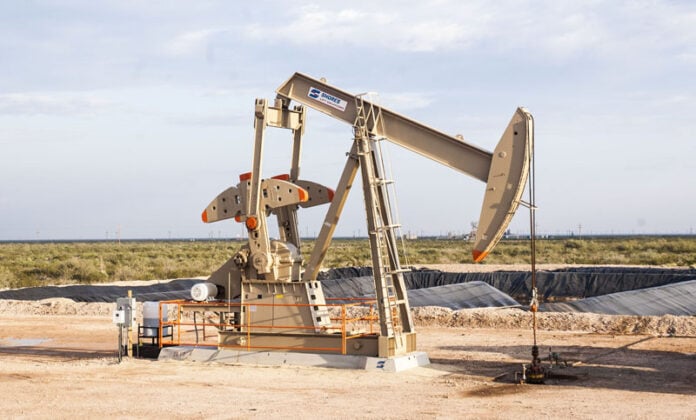Water cut is the percentage of water produced from the well alongside oil and gas. It is typically expressed as a fraction or percentage and measures the ratio of water to the total volume of produced liquids (oil, gas, and water).
For example, if a well produces 80 barrels of oil and 20 barrels of water, the water cut is 20%.
In oil and gas reservoirs, water is present naturally as connate water, or it may be introduced artificially during waterflooding or hydraulic fracturing.
Over time, as the well’s hydrocarbon content depletes, the water cut generally increases, as water moves into the space previously occupied by oil or gas.
Related: What is the API Gravity of Crude Oil?
Water Cut Oil and Gas Formula
Water Cut (%) = (Water Production / (Water Production + Oil Production)) * 100
Where:
- Water Cut (%) represents the percentage of water produced in relation to the total production of fluids (both water and oil).
- Water Production is the volume of water produced, typically measured in barrels per day (bpd) or cubic meters per day (m3/d).
- Oil Production is the volume of oil produced, typically measured in barrels per day (bpd) or cubic meters per day (m3/d).
Let’s consider an example where the total production from the oil well is 20 barrels per day (bpd) and we need to calculate the water cut percentage.
First, we will need to know the Water Production and Oil Production. For this example, let’s assume that the Water Production is 5 bpd and the Oil Production is 15 bpd.
Now, apply the water cut formula:
Water Cut (%) = (Water Production / (Water Production + Oil Production)) * 100
Water Cut (%) = (5 bpd / (5 bpd + 15 bpd)) * 100
Water Cut (%) = (5 / 20) * 100
Water Cut (%) = 0.25 * 100
Water Cut (%) = 25
So, in this example, the water cut is 25%, meaning that 25% of the total production of 20 bpd consists of water and the remaining 75% is oil.
How Water Cut Affects Oil and Gas Production?
The water cut has a negative impact on the efficiency and profitability of an oil well.
A high water cut can lead to reduced oil recovery due to reservoir pressure decline and increased operating costs associated with water separation, treatment, and disposal.
From an environmental perspective, the increased volume of produced water can pose challenges in terms of proper management and disposal, as produced water may contain residual hydrocarbons, chemicals, and naturally occurring radioactive materials.
Therefore, minimizing water production and improving oil recovery rates are critical aspects of oil and gas operations.
Challenges Associated with High Water Cut
Increased Operating Costs
Handling large volumes of produced water can significantly increase operating costs related to water handling, separation, treatment, and disposal. This may affect the profitability of operations, especially when oil prices are low.
Environmental Concerns
Produced water disposal can lead to environmental challenges if not appropriately managed. Disposed water must comply with environmental regulations to minimize the risk of potential surface and groundwater contamination.
Increased Equipment Corrosion
High water cut can lead to increased corrosion in the production equipment due to the presence of corrosive components in the produced water. Corrosion can cause equipment failure, increased maintenance, and higher operational costs.
Related: What Is the Difference Between Brent And WTI Crude Oil?
What is Water Shut Off in Oil Wells?
The primary objective of Water Shut Off is to reduce or eliminate unwanted water production from wells to maintain or increase hydrocarbon production efficiency.
Mechanical Methods
These involve using mechanical tools and downhole equipment to isolate or restrict water-producing zones in the wellbore.
This category includes techniques like:
- Downhole plugs: Devices used to seal off specific water-producing zones or perforations in the casing.
- Inflow control devices: These specially designed devices control water influx by regulating the flow of fluids in the wellbore.
- Cement squeezes: Involves pumping cement slurry to block off water-producing channels or fractures in the formation.
Chemical Methods
These methods involve injecting specialized chemicals into the wellbore or reservoir to alter the flow properties and reduce water production.
Some common chemical treatments are:
- Polymer gels: These are injected into the formation to create a barrier that restricts water flow.
- Relative permeability modifiers (RPMs): These chemicals reduce the permeability of the reservoir rock to water while maintaining or enhancing oil permeability.
- Emulsions and foams: These treatments can be used to block water channels and stabilize fractures, thus reducing water production.
Benefits of Water Shut Off
Implementing Water Shut Off techniques, either mechanical or chemical, has many benefits:
- Enhanced production efficiency: Water Shut Off enhances the hydrocarbon-to-water ratio, resulting in increased production levels and better utilization of resources.
- Cost savings: Controlling water production reduces the need for lifting, handling, and disposing of produced water, leading to cost savings.
- Reduced environmental impact: Water Shut Off results in a lesser need for disposal of produced water, thus minimizing the risk of groundwater contamination and surface pollution.
- Prolonged well life: By controlling water influx and reducing reservoir pressure, Water Shut Off can extend the lifespan of oil and gas wells.
Related: 6 Challenges Facing the Oil and Gas Industry
Other Solutions and Strategies to Manage Water Cut
Use of Produced Water in EOR
Instead of disposing of produced water, some operators choose to treat and reinject it into the reservoir as part of their enhanced oil recovery (EOR) strategy.
This can maintain reservoir pressure and reduce disposal challenges while improving overall oil recovery rates.
Regular Monitoring and Data Analysis
Monitoring water cut trends and analyzing reservoir performance can help operators make informed decisions to prolong well life and maximize oil production.
Advanced data analytics and reservoir simulation models can help to optimize production strategy and minimize the impact of water cut on field economics.
Read next: Composition of Crude Oil
